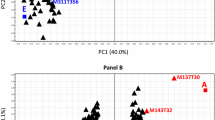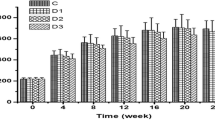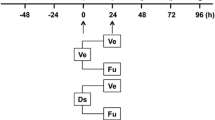Abstract
The metabolomic approach has been widely used in toxicology to investigate mechanisms of toxicity. To understand the mammalian system’s response to nickel exposure, we analysed the NiCl2 induced metabolomic changes in urine of rats using 1H nuclear magnetic resonance (1H NMR) spectroscopy together with clinically relevant biochemical parameters. Male Sprague–Dawley rats were administered intraperitoneally with NiCl2 at doses of 4, 10 and 20 mg/kg body weight. Urine samples were collected at 8, 16, 24, 72, 96 and 120 h post treatment. The metabolomic profile of rat urine showed prominent changes in citrate, dimethylamine, creatinine, choline, trimethylamine oxide (TMAO), phenyl alanine and hippurate at all doses. Principal component analysis of urine 1H NMR spectra demonstrated the dose and time dependent development of toxicity. The metabolomic time trajectory, based on pattern recognition analysis of 1H NMR spectra of urine, illustrated clear separation of pre and post treatments (temporal). Only animals treated with a low dose of NiCl2 returned to normal physiology. The 1H NMR spectral data correlated well with the clinically relevant nephrotoxic biomarkers. The urinary metabolomic phenotyping for NiCl2 induced nephrotoxicity was defined according to the predictive ability of the known metabolite biomarkers, creatinine, citrate and TMAO. The current approach demonstrates that metabolomics, one of the most important platform in system biology, may be a promising tool for identifying and characterizing biochemical responses to toxicity.






Similar content being viewed by others
References
Beutler, E., Duron, O., & Kelly, B. M. (1963). Improved method for the determination of blood glutathione. Journal of Laboratory and Clinical Medicine, 61, 882–888.
Boudonck, K. J., Mitchell, M. W., Nemet, L., et al. (2009). Discovery of metabolomics biomarker for early detection of nephrotoxicity. Toxicologic Pathology, 37, 280–292.
Das, K. K., Das, S. N., & Dhundasi, S. A. (2008). Nickel, its adverse health effects and oxidative stress. Indian Journal of Medical Research, 128, 412–425.
Feng, J., Li, X., Pei, F., et al. (2002). 1H NMR analysis for metabolites in serum and urine from rats administered chronically with La (NO3)3. Analytical Biochemistry, 301, 1–7.
Garrod, S., Humpher, E., Connor, S. C., et al. (2001). High-resolution 1H NMR and magic angle spinning NMR spectroscopic investigation of the biochemical effects of 2-bromoethanamine in intact renal and hepatic tissue. Magnetic Resonance in Medicine, 45, 781–790.
Gavaghan, C. L., Nicholson, J. K., Connor, S. C., et al. (2001). Directly coupled high-performance liquid chromatography and nuclear magnetic resonance spectroscopic with chemometric studies on metabolic variation in Sprague–Dawley rats. Analytical Biochemistry, 291, 245.
Griffin, J. L., Walker, L. A., Shore, R. F., et al. (2001). Metabolic profiling of chronic cadmium exposure in the rat. Chemical Research in Toxicology, 14, 1428–1434.
Hauet, T., Baumert, H., Amor, I. B., et al. (2000). Pharmacological limitation of damage to renal medulla after cold storage and transplantation by trimetazidine. Journal of Pharmacology and Experimental Therapeutics, 292, 254–260.
Holmes, E., Nicholls, A. W., Lindon, J. C., et al. (2000). Chemometric models for toxicity classification based on NMR spectra of biofluids. Chemical Research in Toxicology, 13, 471–478.
Holmes, E., Nicolson, J. K., Bonner, F. W., et al. (1992). Mapping the biochemical trajectory of nephrotoxicity by pattern recognition of NMR urinanalysis. NMR in Biomedicine, 5, 368–372.
Holmes, E., Nicolson, J. K., Nicholls, A. W., et al. (1998). The identification of novel biomarkers of renal toxicity using automatic data reduction techniques and PCA of proton NMR spectra of urine. Chemometrics and Intelligent Laboratory Systems, 44, 245–255.
Khan, A. R., Rana, P., Tyagi, R., et al. (2011). NMR spectroscopy based metabolic profiling of urine and serum for investigation of physiological perturbations during radiation sickness. Metabolomics, 7, 583–592.
Lenz, E. M., Bright, J., Knight, R., et al. (2005). Metabonomics with 1H-NMR spectroscopy and liquid chromatography-mass spectrometry applied to the investigation of metabolic changes caused by gentamycin-induced nephrotoxicity in the rat. Biomarkers, 10, 173–187.
Lindon, J. C., Nicholson, J. K., & Everett, J. R. (1999). NMR spectroscopy of biofluid. Annual Reports on NMR Spectroscopy, 38, 1–88.
Nicholls, A. W., Mortishire-Smith, R. J., & Nicholson, J. K. (2003). NMR spectroscopic-based metabonomic studies of urinary metabolite variation in acclimatizing germ-free rats. Chemical Research in Toxicology, 6, 1395–1404.
Nicholson, J. K., Connelly, J., Lindon, J. C., et al. (2002). Metabonomics: a platform for studying drug toxicity and gene function. Nature Reviews, 1, 153–161.
Nicholson, J. K., & Wilson, I. D. (1989). High-resolution proton magnetic resonance spectroscopy of biological fluids. Progress in Nuclear Magnetic Resonance Spectroscopy, 21, 449–501.
Peiqiu, L., Lai, W., Huifeng, W., et al. (2009). Biochemical effects of gadolinium chloride in rats liver and kidney studied by 1H NMR metabolomics. Journal of Rare Earths, 27, 280–287.
Phipps, A. N., Stewart, J., Wright, B., et al. (1998). Effect of diet on the urinary excretion of hippuric acid and other dietary-derived aromatics in rat, a complex interaction between diet, gut microflora and substrate specificity. Xenobiotica, 28, 527–537.
Portilla, D., Li, S., Nagothu, K. K., et al. (2006). Metabolomic study of cisplatin-induced nephrotoxicity. Kidney International, 69, 2194–2204.
Rezuke, W. N., Knight, J. A., & Sunderman, F. W., Jr. (1987). Reference values for nickel concentrations in human tissues and bile. American Journal of Industrial Medicine, 11, 419–426.
Robosky, L. C., Wells, D. F., Egnash, L. A., et al. (2005). Metabonomic identification of two distinct phenotypes in Sprague–Dawley (Crl:CD(SD)) rats. Toxicological Sciences, 87, 277.
Singh, K. K. (2006). Oxidative stress, disease and cancer. London: Imperial College Press.
Singla, A., Kaur, J., & Mahmood, A. (2006). Alterations in the expression of intestinal enzymes in rats exposed to nickel. Journal of Applied Toxicology, 26, 397–401.
Sun, J., Schnackenberg, L. K., Holland, R. D., et al. (2008). Metabonomics evaluation of urine from rats given acute and chronic doses of acetaminophen using NMR and UPLC/MS. Journal of Chromatography B, 871, 328–340.
Trygg, J., Holmes, E., & Lundstedt, T. (2007). Chemometrices in metabonomics. Journal of Proteome Research, 6, 469–479.
Trygg, J., & Wold, S. (2002). Orthogonal projections to latent structures (O-PLS). Journal of chemometrices, 16, 119–128.
Tyagi, R., Rana, P., Gupta, M., et al. (2011a). Differential biochemical response of rat kidney towards low and high doses of NiCl2 as revealed by NMR spectroscopy. Journal of Applied Toxicology, in press. doi:10.1002/jat.1730.
Tyagi, R., Rana, P., Khan, A. R., et al. (2011b). Study of acute biochemical effects of thallium toxicity in mouse urine by NMR spectroscopy. Journal of Applied Toxicology, 31, 663–670.
Wang, Y., Bollard, M. E., Nicholson, J. K., et al. (2006). Exploration of the direct metabolic effects of mercury II chloride on the kidney of Sprague–Dawley rats using high-resolution magic angle spinning 1H NMR spectroscopy of intact tissue and pattern recognition. Journal of Pharmaceutical and Biomedical Analysis, 40, 375–381.
Wei, L., Liao, P., Wu, H., et al. (2008). Toxicological effects of cinnabar in rats by NMR-based metabolic profiling of urine and serum. Toxicology and Applied Pharmacology, 227, 417–429.
Wu, H., Zhang, X., Li, X., et al. (2006). Investigation on acute biochemical effects of Ce(NO3)3 on liver and kidney tissues by MAS 1H NMR spectroscopic-based metabonomic approach. Journal of Rare Earths, 24, 357–363.
Wu, H., Zhang, X., Liao, P., et al. (2005). NMR spectroscopic-based metabonomic investigation on the acute biochemical effects induced by Ce(NO3)3 in rats. Journal of Inorganic Biochemistry, 99, 2151–2160.
Xu, L. (2004). Methods of chemometrics. Beijing: Science Press.
Acknowledgments
This work was performed as a part of Defence Research & Development Organization (DRDO) sponsored R & D project INM-308. The authors are thankful for the financial support provided by DRDO, Ministry of Defence, India.
Author information
Authors and Affiliations
Corresponding author
Electronic supplementary material
Below is the link to the electronic supplementary material.
11306_2011_390_MOESM2_ESM.tif
Supplementary Fig. 1b: Relative change in the integral value of lactate from rat exposed to three doses of (4, 10 and 20 mg/kg b.w.) NiCl2 at 24 h. (TIFF 23 kb)
11306_2011_390_MOESM3_ESM.tif
Supplementary Fig. 2: PCA Scores plot of 1H NMR spectra of urine sampled at 96 h from control rats (○, n = 5) and NiCl2 doses with 4 (●, n = 5); 10 (■, n = 5); and 20 (▲, n = 5) mg/kg body weight dose. (TIFF 37 kb)
Rights and permissions
About this article
Cite this article
Tyagi, R., Rana, P., Gupta, M. et al. Urinary metabolomic phenotyping of nickel induced acute toxicity in rat: an NMR spectroscopy approach. Metabolomics 8, 940–950 (2012). https://doi.org/10.1007/s11306-011-0390-4
Received:
Accepted:
Published:
Issue Date:
DOI: https://doi.org/10.1007/s11306-011-0390-4




